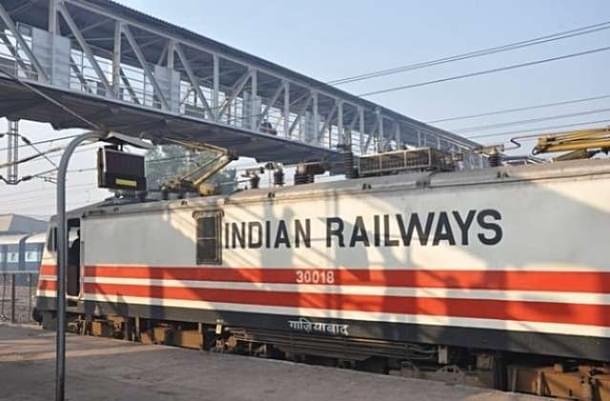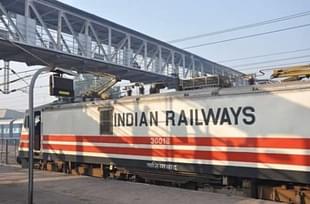Infrastructure
Feku Federalism Or Formality of Feeble, Facetious Faultfinding?
Aashish Chandorkar
Feb 17, 2018, 03:11 PM | Updated 03:11 PM IST
Save & read from anywhere!
Bookmark stories for easy access on any device or the Swarajya app.


Just as Indian Railways closes in on a year which saw record laying of new tracks, record electrification of the existing tracks, new investments for overcrowded cities, and a gradual but sure improvement in safety standards, the opposition has trained guns on the public sector giant. The Railways Minister Piyush Goyal will face scrutiny in the second half of the budget session of Parliament from an irate opposition, searching for new areas to corner the government on. But Goyal’s arrival in the Railways Ministry has given it his characteristic data-driven flavour and for almost all the questions raised by the opposition, he will likely have credible answers.
Spending On Safety
The opposition has pilloried the 2018 budget for allocating only Rs 500 crore for the Depreciation Reserve Fund. The government is now using the Rashtriya Rail Sanraksha Kosh (RRSK) to spend on safety related projects, which will be funded from the operations. So the charge of ignoring safety related capital expenditure is not correct. In fact, this was the first area where Goyal focused on after taking over as the Railways Minister.
Railways witnessed a series of ghastly accidents, possibly even sabotage, over 2016-17. One of the early decisions Goyal made was to stop manufacturing the 60-year-old Integral Coach Factory design coaches, which will be accomplished by June this year. The increased use of Linke Hofman Busch coaches will make travel safer, but replacing the stock is a multiyear project. Goyal also plans to get global suppliers of the state-of-the-art European Train Control System signalling technology, which may cost up to $12 billion. He is looking to realise economies of scale, opening 118,000 line kilometres of signalling upgrade.
The average spend on safety from revenues under the Narendra Modi government has been Rs 37,500 crore. The proposal for the next financial year is Rs 73,000 crore. The overall capex planned for the next year is Rs 148,528 crore as opposed to Rs 53,989 in 2013-14, a 2.75 times increase. There is no merit to the charge that there is underinvestment in Railways.
State-Specific Favoritism
One of the allegations against the current budget is that it has increased spend for the Bharatiya Janata Party (BJP) states, but decreased spend for West Bengal, Kerala, and Delhi, which are governed by various opposition parties. Given that subsequent Railways ministers have used the department as a lever for regional one-upmanship, the opposition to poorer states benefiting sounds preposterous.
During the United Progressive Alliance (UPA)-2 tenure, the Railways portfolio was handled by the Trinamool Congress Party for a large part of the term. Just between 2009 and 2011, West Bengal got 65 out of the 383 new trains and 83 out of 576 train stoppages. If such skewed baselines are used as benchmarks, it is but natural that the past beneficiary states will likely see some decline in new investments!
Even then, over the five-year period from 2014 to 2019 (planned), allocations for all states have gone up. Over the previous five year period - the UPA-2 term - Kerala and Delhi (156 per cent each) have actually witnessed a big jump in investments. Even West Bengal has got 5 per cent more allocations, despite the high base effect.
Another non-BJP state where Railways is making sizeable investments is Karnataka. New projects which reduce the distance from Bangalore to Delhi and Mumbai, and capacity expansion between Bangalore and Mysore are being undertaken. Several of these projects were announced years ago, some by Mallikarjun Kharge - the Congress leader in the Lok Sabha.
Railways are now linking every capital in the North East - these cities have waited almost 75 years after Independence to see a train! States such as Madhya Pradesh, Chhattisgarh, and Jharkhand are seeing railway projects pending for three to four decades finally moving towards completion.
State Funding Of Projects
One of the charges levelled against the government is that it is asking states to fund new projects, despite Railways being a Union subject. This is a classic case of denouncing fiscal innovation in the name of rigid rules.
Starting with the tenure of Suresh Prabhu as the minister, Railways has been looking to generate new funds, including off-balance sheet funding. The Life Insurance Corporation of India (LIC) had committed Rs 150,000 crore over a period of time for Railways to tap. Another measure was to ask individual states to fund critical projects.
This measure should actually be lauded - this gives an opportunity for the states to plug specific transportation gaps. States may have own reasons to do so - linkages for agriculture markets or hauling natural resources, creating easier commuting options between industrial towns - there are several areas of state specificity which can be addressed through these targeted interventions.
Bullet Trains Vs Your Pet Peeve
Indian media and opposition have beaten the bullet train project to death comparing the Rs 98,000 crore investments to all kinds of shortcomings in other areas.
The Japan International Corporation Agency (JICA) has purpose-funded this project, which will be a win-win for both countries. The Japanese industrial capacity can only be utilised through overseas projects, while India needs modern commuting options. Japanese companies will be creating significant manufacturing capacity in India, supporting the Make In India initiative and creating a platform for the next round of bullet train/high speed rail launches. Besides the current Mumbai-Ahmadabad bullet train project is just the first of the many others which will connect cities in 300 to 500 kilometre distance.
The funding for this project does not take away anything from any other project. Conversely, this funding could not have been routed elsewhere, as this is a project specific funding - the volume as well as the terms of repayment. Of course the government can ask JICA to invest in other Indian infrastructure projects, and as a matter of fact, that’s already happening.
The Mumbai-Ahmadabad bullet train isn’t cannibalising anything else!
Vacancies
Railways have long faced the criticism of not filling up almost 1.28 lakh job vacancies.
Before the budget session discussions commence, Goyal would have addressed this issue already. Recruitment notification was already issued soon after the budget for 26,500 assistant loco pilots and technicians. In addition, another 63,000 vacancies are being filled across the department, making the effort the single largest recruitment effort in the country.
The Railways also plans to take in almost 30,000 apprentices in an effort to support the Skills India programme.
Use Of Bio-Toilets
Although no previous government really invested anything in either cleanliness infrastructure, nor in changing user habits, the members of these same past governments are questioning the Modi government on apparent slow implementation of Swachha Bharat. In the context of Railways, use of bio-toilets is a big task under the Swachh Bharat programme.
The Railways have already fitted more than 30,000 coaches with these bio-toilets. In one of her Railways budget speeches, West Bengal Chief Minister Mamata Banerjee had talked about Vision 2020 for providing bio-toilets in all coaches across the Indian rail network. No specific investments backed up the announcement until Swachha Bharat programme was launched in October 2014. However, Banerjee will be certainly pleased to see her vision become a reality now. In fact, the target to equip all coaches with bio-toilets is now 2019, a year ahead of Banerjee’s dream vision.
New Railway Lines
The work of construction of new lines, gauge conversions, and doubling of railway lines all missed the target in 2017-18. The targets for 2018-19 are more realistic – 1,000 km each of new lines and gauge conversion and 2,100 km of doubling.
While there was a miss on the new rail lines and capacity expansion, this was a trade-off with safety and maintenance. Railways will do track maintenance of 4,300 km this financial year, highest ever in its history and 20 per cent over the budget. Track renewals have been prioritised for now, and given the limited capacity which Steel Authority of India has, the import route has also been activated for rails.
Another area of rail line improvement has been route electrification. From an average of 654 route km during UPA-2, the electrification has increased to 1,493 route km in the first three years of the Modi government. In 2017-18, the government may hit the 4,000 route km electrification mark, with a target of 6,000 route km in 2018-19.
Goyal will have to deal with the challenges of improving operating ratio, which has deteriorated in the wake of the recent pay commission implementation. Generating enough sources of monetisation for Railways should be his focus once all the safety related projects have been kicked off.
To his credit, Goyal is also directing large investments towards higher returns in Mumbai and Bangalore. The Mass Urban Transport Project in Mumbai and the part-elevated, part-on ground suburban rail expansion in Bangalore should have come decades ago. But the 150 odd km of new lines which both the cities will get will go a long way in decongesting these metros.
The opposition, meanwhile, has termed the Railways budget as Feku Federalism - in reality the criticism appears forced and facetious. The Railways have embarked on a path of change dealing with severe operating constraints - the current technology-led improvement plans must be welcomed and supported.
Aashish Chandorkar is Counsellor at the Permanent Mission of India to the World Trade Organization in Geneva. He took up this role in September 2021. He writes on public policy in his personal capacity.





